New in the Gallery: 1958 Topps Virtual Uncut Sheet
August 17th, 2010 | Published in Football Card Trivia, New in the Gallery
August 17th, 2010 | Published in Football Card Trivia, New in the Gallery
July 27th, 2010 | Published in Football Card Trivia, Interactive Team Cards, New in the Gallery, Sites I Like
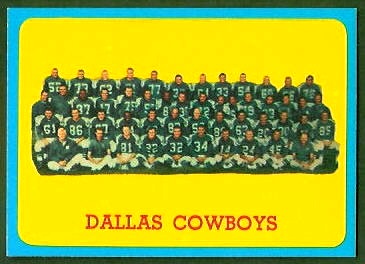 Yesterday I added an “interactive” 1963 Topps Dallas Cowboys team card to the Vintage Football Card Gallery. By placing the cursor over a player, you can see who the player is, and by clicking on him, you can see all of his cards. (It doesn’t work on the card pictured here–you have to go to the gallery page.) As the gallery page says, this 1963 card actually pictures the 1960 Cowboys team, and only eight of the players were still with the team when the card was issued.
Yesterday I added an “interactive” 1963 Topps Dallas Cowboys team card to the Vintage Football Card Gallery. By placing the cursor over a player, you can see who the player is, and by clicking on him, you can see all of his cards. (It doesn’t work on the card pictured here–you have to go to the gallery page.) As the gallery page says, this 1963 card actually pictures the 1960 Cowboys team, and only eight of the players were still with the team when the card was issued.
The Cowboys were an expansion team in 1960, and they obtained most of their players from the other teams via an expansion draft. Each of the other teams made nine players available, and the Cowboys chose three of them. Like the other teams, the Cowboys also obtained players via trades, free agency, and other teams’ waiver lists. Unfortunately, the league approved the franchise too late for the Cowboys to participate in the college draft, and the team also had to compete with the upstart AFL for free agents. The result: a 0-11-1 season.
To see how the Cowboys assembled their original team, check out The Original 1960 Dallas Cowboys Roster at thecowboysguide.com. The page includes pictures of the team-issued photos for most of the players, and it also shows many of the players’ first cards. Very interesting!
July 26th, 2010 | Published in Football Card Trivia
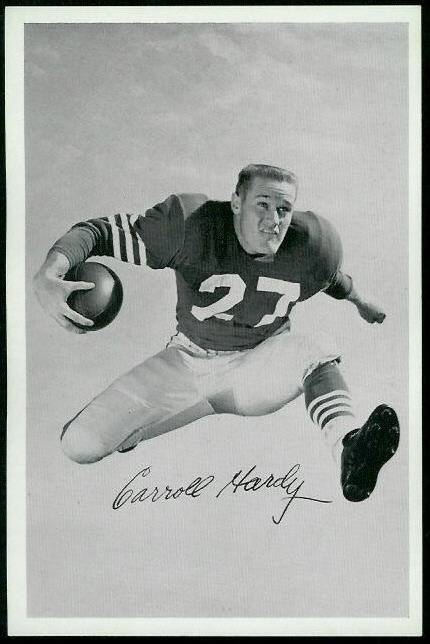 I have always loved this photo of Carroll Hardy, and yesterday I did an eBay search to see if I could find him on any more 49er team issues. To my surprise, a bunch of baseball cards popped up! Not being a baseball card collector, I didn’t know that after a short NFL career, Hardy had played eight seasons in the major leagues. Perhaps, conversely, most baseball card collectors don’t know about his short NFL career?
I have always loved this photo of Carroll Hardy, and yesterday I did an eBay search to see if I could find him on any more 49er team issues. To my surprise, a bunch of baseball cards popped up! Not being a baseball card collector, I didn’t know that after a short NFL career, Hardy had played eight seasons in the major leagues. Perhaps, conversely, most baseball card collectors don’t know about his short NFL career?
According to his Wikipedia page, Hardy spent just one year with the 49ers, 1955, when this 49ers team issue photo was released. He gained 37 yards rushing and 338 yards receiving for the season, and four of his receptions were for touchdowns.
He went on, after two years in the minor leagues, to become a backup outfielder for the Cleveland Indians, Boston Red Sox, Houston Colt .45s, and Minnesota Twins. He was the only player to pinch-hit for Ted Williams, and he also pinch-hit for Roger Maris and Carl Yastrzemski.
You can see the rest of the 1955 49ers Team Issue photos in the Vintage Football Card Gallery.
July 21st, 2010 | Published in Football Card Trivia, Interactive Team Cards, New in the Gallery
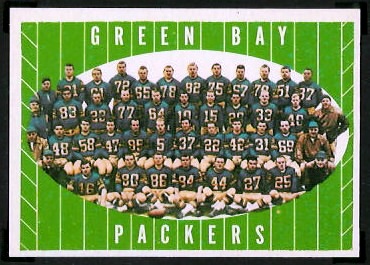 Yesterday I added an “interactive” 1961 Topps Packers Team Card to the Vintage Football Card Gallery. By placing the cursor over a player, you can see who the player is, and by clicking on him, you can see all of his cards. (It doesn’t work on the card pictured here–you have to go to the gallery page.)
Yesterday I added an “interactive” 1961 Topps Packers Team Card to the Vintage Football Card Gallery. By placing the cursor over a player, you can see who the player is, and by clicking on him, you can see all of his cards. (It doesn’t work on the card pictured here–you have to go to the gallery page.)
In the process of looking up the players, I learned a few things:
For more gallery features, see A Tour of the Vintage Football Card Gallery.
July 16th, 2010 | Published in Football Card Trivia, Sites I Like, Uniforms
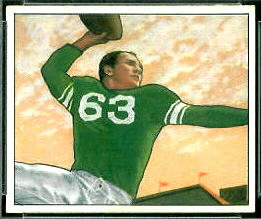 Ever wonder why all of the Baltimore Colts in the 1950 Bowman set are wearing green? Did Bowman take liberties with the team’s colors, as Topps did with the Houston Oilers in 1961? (See Houston Oilers: Pretty in Pink.) Did the team change colors from green to blue sometime after 1950?
Ever wonder why all of the Baltimore Colts in the 1950 Bowman set are wearing green? Did Bowman take liberties with the team’s colors, as Topps did with the Houston Oilers in 1961? (See Houston Oilers: Pretty in Pink.) Did the team change colors from green to blue sometime after 1950?
No, the 1950 Colts were actually a different franchise than today’s Colts. The original Colts were members of the AAFC, and they were one of three teams to join the NFL when the AAFC folded after the 1949 season. This Colts team lasted just one year in the NFL before disbanding, and in 1951 the Colts players were made available to the remaining teams via the draft.
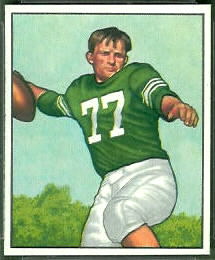 In 1953, the NFL awarded a Baltimore group a new franchise and gave it the remnants of the original Dallas Texans, a franchise that had lasted just one year in Dallas. The new Colts wore blue, and they’ve worn blue ever since. A nice article by Bob Carroll on the profootballresearchers.com web site traces the lineage of the two Colts franchises and the other AAFC teams.
In 1953, the NFL awarded a Baltimore group a new franchise and gave it the remnants of the original Dallas Texans, a franchise that had lasted just one year in Dallas. The new Colts wore blue, and they’ve worn blue ever since. A nice article by Bob Carroll on the profootballresearchers.com web site traces the lineage of the two Colts franchises and the other AAFC teams.
Pictured here are cards of two of the Colts cards in the 1950 Bowman set, Y.A. Tittle and Chet Mutryn. You can see the entire 1950 Bowman Baltimore Colts team set in the Vintage Football Card Gallery.
Here’s a bit of trivia: Besides Y.A. Tittle, what Hall of Fame quarterback played for the Colts in 1950?
Answer: George Blanda. The Bears traded Blanda and four other players to the Colts on September 5. Blanda played in one game for the Colts, and the Bears bought him back on September 20.
July 8th, 2010 | Published in Football Card Trivia, Sites I Like, Uniforms
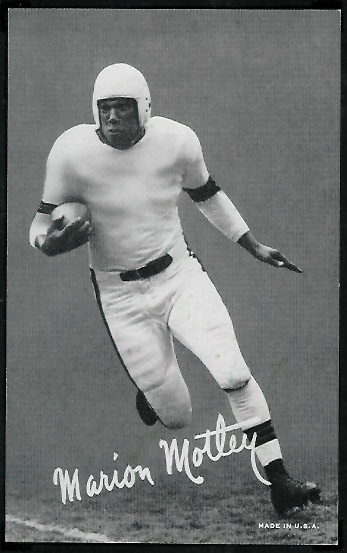 I picked up this card a couple of weeks ago; it’s an Exhibit card of Marion Motley, printed between 1948 and 1952. Motley was one of the first four African Americans to play professional football, and he was the second African American to be inducted into the Pro Football Hall of Fame. (Em Tunnell was the first.)
I picked up this card a couple of weeks ago; it’s an Exhibit card of Marion Motley, printed between 1948 and 1952. Motley was one of the first four African Americans to play professional football, and he was the second African American to be inducted into the Pro Football Hall of Fame. (Em Tunnell was the first.)
This is one of my first Exhibit cards, and I’m finding that there is a lot to learn about them. A good place to start is Adam Warshaw’s page called “Interesting Exhibit Cards.” Adam’s article provides a nice introduction to the cards, along with many, many pictures. According to his article, “Exhibit cards were the first nationally distributed sports card product sold without any ancillary uses or purposes,” meaning that they were not used to help sell some other product. Football players were just a few of the people featured on Exhibit cards: there were other athletes, movie stars, musicians, and, well, just see Adam’s page. Exhibit cards were dispensed from vending machines, and you can see pictures of a few of the machines on photobucket.
When I bought the Motley card, I assumed that it was a pre-rookie card, and I intended to add it to my pre-rookie cards page. I am not sure now, though, that it was printed before his 1950 Bowman rookie card. Exhibit cards don’t have dates printed on them, but by looking for slight variations, you apparently can narrow down the possible printing dates. According to a page at centuryoldcards.com, the size and case of the “MADE IN THE U.S.A.” line on the bottom of Exhibit baseball cards indicates when they were printed. The “MADE IN THE U.S.A.” line on my Motley card is all in upper case, and it measures 5/8 of an inch horizontally, suggesting that the card was printed in 1948–if football cards had the same variations as baseball cards. My old Beckett catalog, though, says that 1948 Exhibit football cards had a line at the bottom describing the player. (See eBay for examples.) In fact, my Beckett catalog distinguishes the 1948 cards from the 1949-1952 cards, saying that the 1948 cards are from the “Exhibit Sports Champion” set. Since the guidelines at centuryoldcards.com don’t appear to jibe with Beckett when applied to football cards, I’m not certain when my card was printed.
I get the sense that Beckett created a separate set for the 1948 Exhibit cards because they were easy to distinguish from the later years. The variations in the text on the 1949-1952 cards are less obvious, and I’m guessing that that’s why Beckett lumped those years together. The other card guides group all of the Exhibit football cards together and call them 1948-1952 Exhibits. To me that makes sense, since there were a lot of variations among the cards, and no one seems to have a firm grasp on which cards were printed with which variations. Besides the variations mentioned above, some cards were printed with different tints, and some were printed with postcard backs. The small images here show some variations from a recent Heritage Auctions listing. (The listing also includes larger images, but you have to register to see them.)
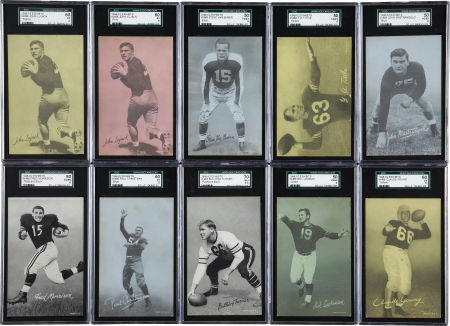
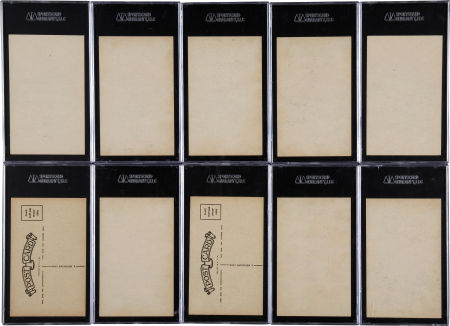
Back to my Motley card: I wondered about his number-less jersey, so I did some searching for it. I thought that maybe it was an old college jersey, or that maybe the Browns didn’t wear numbers in their early days in the AAFC. I didn’t find the image anywhere else, though, and I concluded that it was a Browns practice jersey. Blackpast.com has a photo of Motley in action as a Brown, and the jersey number is the only difference between the uniform he is wearing in that photo and the one he is wearing on my card. It’s curious that the Exhibit card pictures him in a practice jersey, but the all-white uniform does make for a striking image.
You might have noticed that, in the image at blackpast.com, Motley is wearing Chuck Taylors. The Browns evidently wore Chucks when the field was frozen, because I found an image of other team members changing into them during the 1950 Championship game. I believe number 59 is Horace Gillom–check out his monster facemask!
June 11th, 2010 | Published in Football Card Trivia
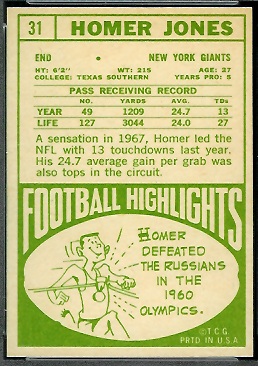 One day, while scanning cards, I noticed that the cartoon on the back of Homer Jones’s 1968 Topps card said that “Homer defeated the Russians in the 1960 Olympics.” Hmm, I thought, that’s a good idea for a blog article. There was a problem, though: I couldn’t find a reference saying that Jones had ever competed in the Olympics. He was a star sprinter at Texas Southern, and he might have defeated the Russians in some competition, but it doesn’t appear to have been in the Olympic Games. (According to his Wikipedia page, however, Jones did invent the touchdown spike, which is “said to be the origin of post-touchdown celebrations.” While not quite beating the Russians, that’s still quite a legacy.)
One day, while scanning cards, I noticed that the cartoon on the back of Homer Jones’s 1968 Topps card said that “Homer defeated the Russians in the 1960 Olympics.” Hmm, I thought, that’s a good idea for a blog article. There was a problem, though: I couldn’t find a reference saying that Jones had ever competed in the Olympics. He was a star sprinter at Texas Southern, and he might have defeated the Russians in some competition, but it doesn’t appear to have been in the Olympic Games. (According to his Wikipedia page, however, Jones did invent the touchdown spike, which is “said to be the origin of post-touchdown celebrations.” While not quite beating the Russians, that’s still quite a legacy.)
In my research for Jones, I found a list of other pro football players who had competed in the Olympics. It’s a long list, so I narrowed it down to those who had won medals, and then to those who appeared on vintage football cards. That left six players, a number suitable for a blog article. I also added one more I knew of, Brick Muller.
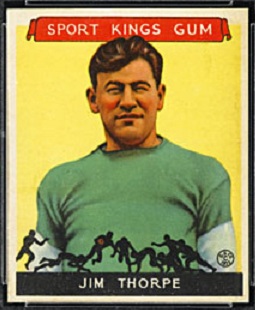 Jim Thorpe won gold medals in the pentathlon and decathlon in the Stockholm Olympics in 1912. In 1913, the International Olympic Committee took the medals away when they learned that Thorpe had played minor league baseball (and thus had been a professional athlete) before participating in the Olympics. In 1982, Thorpe’s family succeeded in having his medals restored.
Jim Thorpe won gold medals in the pentathlon and decathlon in the Stockholm Olympics in 1912. In 1913, the International Olympic Committee took the medals away when they learned that Thorpe had played minor league baseball (and thus had been a professional athlete) before participating in the Olympics. In 1982, Thorpe’s family succeeded in having his medals restored.
Thorpe played professional football from 1915 to 1928, for six different teams. He was a member of the Pro Football Hall of Fame’s inaugural class in 1963. Thorpe also played professional baseball–including seven seasons in the major leagues–from 1909 to 1922. Pictured here is his rookie card, from the 1933 Sport Kings multi-sport set.
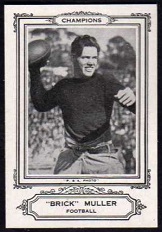 Brick Muller took a silver medal in the high jump at the 1920 Olympics in Antwerp. He played and coached one season in the NFL, 1926, for the Los Angeles Buccaneers. (The Buccaneers lasted just one season in the NFL.) Like Jim Thorpe, in 1951 he was among the inaugural class of players elected to College Football Hall of Fame. Muller is shown here on his 1926 Spalding Champions card. He also appeared on a 1955 Topps All-American football card.
Brick Muller took a silver medal in the high jump at the 1920 Olympics in Antwerp. He played and coached one season in the NFL, 1926, for the Los Angeles Buccaneers. (The Buccaneers lasted just one season in the NFL.) Like Jim Thorpe, in 1951 he was among the inaugural class of players elected to College Football Hall of Fame. Muller is shown here on his 1926 Spalding Champions card. He also appeared on a 1955 Topps All-American football card.
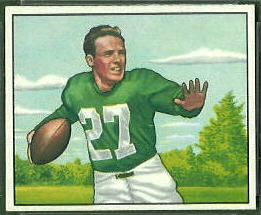 Clyde Scott won a silver medal in the 110 meter hurdles in the 1948 Olympics in London. He played four seasons in the NFL, as a running back and defensive back for the Eagles and Lions. He appeared on the 1950 Bowman card pictured here, and on a 1951 Bowman card. According to Scott’s profile on the Encyclopedia of Arkansas web site, the readers of the Arkansas Democrat-Gazette named Scott the state’s Athlete of the Century in 2000.
Clyde Scott won a silver medal in the 110 meter hurdles in the 1948 Olympics in London. He played four seasons in the NFL, as a running back and defensive back for the Eagles and Lions. He appeared on the 1950 Bowman card pictured here, and on a 1951 Bowman card. According to Scott’s profile on the Encyclopedia of Arkansas web site, the readers of the Arkansas Democrat-Gazette named Scott the state’s Athlete of the Century in 2000.
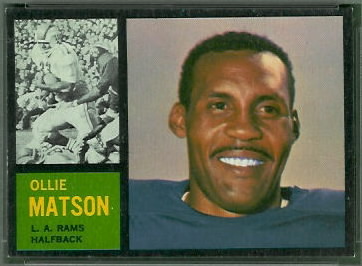 Ollie Matson won a bronze medal in the 400 meters and a silver in the 1600 meter relay in the 1952 Olympics in Helsinki. He then had a fourteen-year, Hall of Fame career in the NFL. Matson appeared on a lot of cards. Pictured here is his 1962 Topps card.
Ollie Matson won a bronze medal in the 400 meters and a silver in the 1600 meter relay in the 1952 Olympics in Helsinki. He then had a fourteen-year, Hall of Fame career in the NFL. Matson appeared on a lot of cards. Pictured here is his 1962 Topps card.
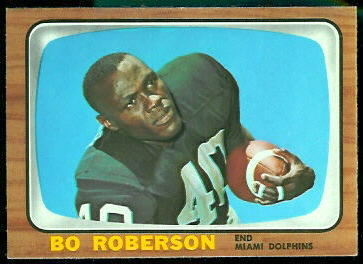 Bo Roberson took silver in the long jump in the 1960 Olympics in Rome, missing the gold medal by a centimeter. He then played six seasons in the AFL, for four different teams. His 1966 Topps card is pictured here. According to a his profile at ivy50.com, after football, Roberson attended law school, earned a master’s degree at Whitworth College, and earned his doctorate degree at age 58. Wow.
Bo Roberson took silver in the long jump in the 1960 Olympics in Rome, missing the gold medal by a centimeter. He then played six seasons in the AFL, for four different teams. His 1966 Topps card is pictured here. According to a his profile at ivy50.com, after football, Roberson attended law school, earned a master’s degree at Whitworth College, and earned his doctorate degree at age 58. Wow.
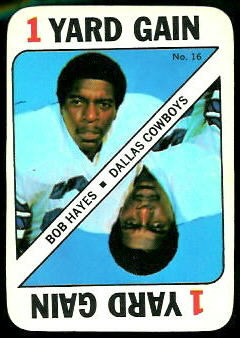 “Bullet” Bob Hayes won two gold medals in the 1964 Tokyo Olympics, in the 100 meter sprint and 400 meter relay. Hayes then played wide receiver for eleven years for the Cowboys and 49ers, and he was elected to the Pro Football Hall of Fame in 2009. Hayes appeared on many football cards; the one pictured here is a 1971 Topps Game card.
“Bullet” Bob Hayes won two gold medals in the 1964 Tokyo Olympics, in the 100 meter sprint and 400 meter relay. Hayes then played wide receiver for eleven years for the Cowboys and 49ers, and he was elected to the Pro Football Hall of Fame in 2009. Hayes appeared on many football cards; the one pictured here is a 1971 Topps Game card.
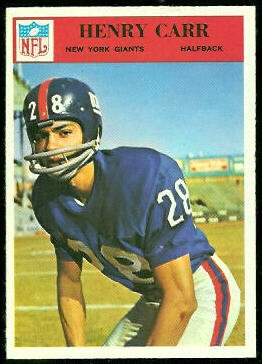 Henry Carr also won two gold medals in the 1964 Tokyo Games, in the 200 meter sprint and 1600 meter relay. The New York Giants, according to an article at pe.com, then signed Carr primarily to cover Bob Hayes. Carr spent three years with the Giants, the highlight of his career being a 101-yard interception return for a touchdown in 1966. His 1966 Philadelphia card is pictured here.
Henry Carr also won two gold medals in the 1964 Tokyo Games, in the 200 meter sprint and 1600 meter relay. The New York Giants, according to an article at pe.com, then signed Carr primarily to cover Bob Hayes. Carr spent three years with the Giants, the highlight of his career being a 101-yard interception return for a touchdown in 1966. His 1966 Philadelphia card is pictured here.
June 4th, 2010 | Published in Football Card Trivia
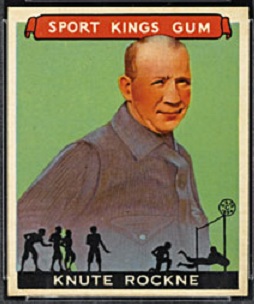 I started to write an article today about coaches on football cards, but then I realized that a lot of coaches appeared on football cards–too many to cover in one article. So I thought I’d break the subject into blog-sized pieces. This is the first.
I started to write an article today about coaches on football cards, but then I realized that a lot of coaches appeared on football cards–too many to cover in one article. So I thought I’d break the subject into blog-sized pieces. This is the first.
Knute Rockne was the first coach to appear on a football card–or at least he’s the first I can think of. Pictured here is Rockne’s rookie card, from the 1933 Goudey Sport Kings multi-sport set. This is one of three football cards in the set, the others being Red Grange and Jim Thorpe. (The Virtual Card Collection web site shows all of the cards in the Sport Kings set.)
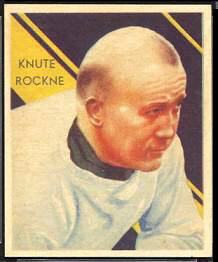 Until today, when I visited his official web site, I hadn’t realized that Rockne died in 1931, two years before his Sport Kings card was issued. He was only 43 when he was killed in a plane crash in Kansas, on his way to Los Angeles to assist with “The Spirit of Notre Dame,” a movie about–what else?–Notre Dame football. According to his Wikipedia page, “Rockne was…shrewd enough to recognize that intercollegiate sports had a show-business aspect. Thus he worked hard promoting Notre Dame football so as to make it financially successful.” His IMDB page shows that he worked on a number of short films released in 1931.
Until today, when I visited his official web site, I hadn’t realized that Rockne died in 1931, two years before his Sport Kings card was issued. He was only 43 when he was killed in a plane crash in Kansas, on his way to Los Angeles to assist with “The Spirit of Notre Dame,” a movie about–what else?–Notre Dame football. According to his Wikipedia page, “Rockne was…shrewd enough to recognize that intercollegiate sports had a show-business aspect. Thus he worked hard promoting Notre Dame football so as to make it financially successful.” His IMDB page shows that he worked on a number of short films released in 1931.
Rockne was also the second coach to appear on a football card, this one in the 1935 National Chicle set. His is definitely the odd card in this set, since the rest of the National Chicle cards show NFL players of the day. The image on Rockne’s National Chicle card also appeared on his 1955 Topps All-American card.
June 3rd, 2010 | Published in Football Card Trivia
Last year I wrote about players who appeared on other players’ cards, and I noted that some players who made guest appearances never appeared on cards of their own. Today I dug up a few more cards with uncredited players.
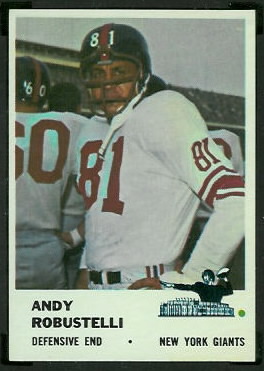 First is Andy Robustelli’s 1961 Fleer card. Number 60 from the Giants also appears on the card, with his back to the camera. Who is it? Well, there was no number 60 on the Giants’ 1961 roster, but the photo was probably taken the year before, and number 60 on the Giants’ 1960 roster was Bill Crawford. Crawford played in four games in 1960, but that was the extent of his NFL career, so having his back appear on another player’s card was a reasonably good showing. According to cflapedia.com, Crawford also went on to play in the CFL for four seasons. I don’t believe he appeared on a CFL card, though.
First is Andy Robustelli’s 1961 Fleer card. Number 60 from the Giants also appears on the card, with his back to the camera. Who is it? Well, there was no number 60 on the Giants’ 1961 roster, but the photo was probably taken the year before, and number 60 on the Giants’ 1960 roster was Bill Crawford. Crawford played in four games in 1960, but that was the extent of his NFL career, so having his back appear on another player’s card was a reasonably good showing. According to cflapedia.com, Crawford also went on to play in the CFL for four seasons. I don’t believe he appeared on a CFL card, though.
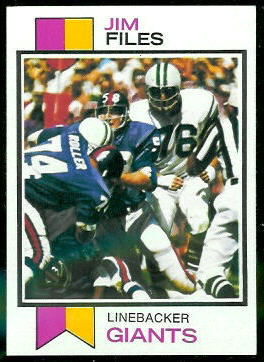 Next is a 1973 Topps Jim Files card, which actually shows two other players more clearly than Files. One of the players is Dave Roller, who played for the Giants in 1971. (He might also have been on the roster other years, but according to his page on pro-football-reference.com, he did not play.) Roller went on to play six seasons for the Packers and Vikings, but, as far as I know, he never appeared on a card of his own.
Next is a 1973 Topps Jim Files card, which actually shows two other players more clearly than Files. One of the players is Dave Roller, who played for the Giants in 1971. (He might also have been on the roster other years, but according to his page on pro-football-reference.com, he did not play.) Roller went on to play six seasons for the Packers and Vikings, but, as far as I know, he never appeared on a card of his own.
The other player on the Jim Files card, number 76, appears to be Fred Miller, a defensive tackle for the Colts from 1963 to 1972. Though Miller had a long career and made the Pro Bowl three times, he did not appear on a regular issue card. Perhaps, if he had played another year, he would have made it onto a 1973 Topps card, since Topps increased the size of their football card set from 351 cards to 528 in 1973. Miller did appear on a couple of oddball items–a 1967 Williams Portrait and a 1967 Johnny Pro Die-Cut–that you can sometimes spot on eBay.
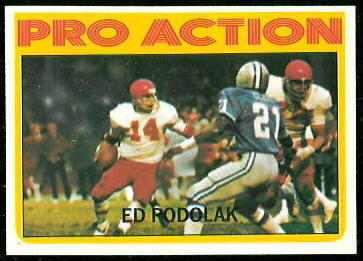 Finally, we have a 1972 Topps Ed Podolak Pro Action card. The defensive player on the card–who’d like to smack that ball away from Podolak–appears to be Al Clark of the Lions. Clark spent the 1971 season with Detroit, then played five seasons for the Rams and Eagles. I don’t know of any other cards of Clank.
Finally, we have a 1972 Topps Ed Podolak Pro Action card. The defensive player on the card–who’d like to smack that ball away from Podolak–appears to be Al Clark of the Lions. Clark spent the 1971 season with Detroit, then played five seasons for the Rams and Eagles. I don’t know of any other cards of Clank.
I frequently get inquiries from the families and friends of players who had short pro careers, and I have to tell them, sadly, that I don’t know of any cards of their uncle or granddad or friend. If I had more of these uncredited players cataloged, I could probably sell more cards!
May 29th, 2010 | Published in Football Card Trivia, New in the Gallery, Oddball, Sites I Like
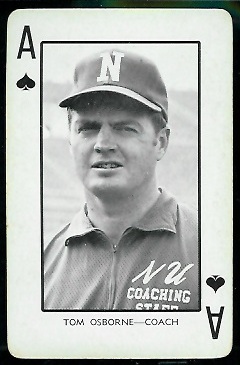 Yesterday I added 1973 Nebraska Playing Cards to the Vintage Football Card Gallery. This standard deck of cards includes fifty-one cards of players, two cards (the jokers) showing a packed Memorial Stadium, and one card picturing coach Tom Osborne. Osborne coached the Cornhuskers for twenty-five years, and 1973 happened to be his first season.
Yesterday I added 1973 Nebraska Playing Cards to the Vintage Football Card Gallery. This standard deck of cards includes fifty-one cards of players, two cards (the jokers) showing a packed Memorial Stadium, and one card picturing coach Tom Osborne. Osborne coached the Cornhuskers for twenty-five years, and 1973 happened to be his first season.
A page on Wikipedia summarizes the 1973 Cornhusker season in detail. According to that page, twenty-four members of the 1973 Nebraska team went on to play professionally: fourteen in the NFL, three in the CFL, and seven in the World Football League. Nineteen of those players are included in my deck of playing cards. Coach Osborne had also spent some time in the NFL: he was a receiver for the Washington Redskins for two seasons in the early 1960s.
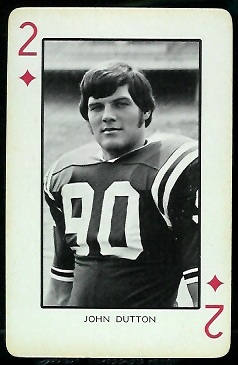 Of the 1973 Huskers who made the NFL, John Dutton, a defensive end, was the most successful. Dutton played fourteen seasons for the Baltimore Colts and Dallas Cowboys, and he went to the Pro Bowl three times. He appeared on a lot of football cards as a professional, too. I don’t have any of them, since they are newer, but a lot of them are listed on eBay.
Of the 1973 Huskers who made the NFL, John Dutton, a defensive end, was the most successful. Dutton played fourteen seasons for the Baltimore Colts and Dallas Cowboys, and he went to the Pro Bowl three times. He appeared on a lot of football cards as a professional, too. I don’t have any of them, since they are newer, but a lot of them are listed on eBay.
As far as I know, Bob Martin is the only other player in the 1973 playing card set who also appeared on a card as a professional. Martin played linebacker for four years for the Jets and 49ers, and he appeared on a 1980 Topps football card. You can find that card on eBay, too.
Two more players, Bob Nelson and Dave Humm, had ten-year NFL careers, and Nelson was a member of two Raiders teams that won the Super Bowl. Both played in reserve roles, though, and they did not make it onto cards as pros. They and several other 1973 Huskers later appeared in the 1989 Leesley set, however. I am not familiar with the Leesley cards, but they appear to be a Nebraska all-time star set. You guessed it: you can find them on eBay.
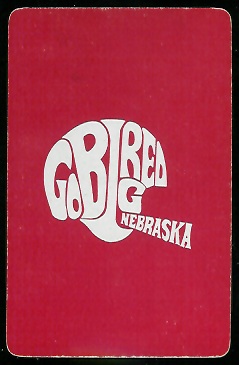 In my research for this set, I also turned up a site called HuskerJ’s Collectibles. HuskerJ has pictures of a few more decks of Nebraska playing cards–as well as many more Cornhusker toys. The other decks of playing cards don’t appear to feature individual players, but they’re worth a peek.
In my research for this set, I also turned up a site called HuskerJ’s Collectibles. HuskerJ has pictures of a few more decks of Nebraska playing cards–as well as many more Cornhusker toys. The other decks of playing cards don’t appear to feature individual players, but they’re worth a peek.